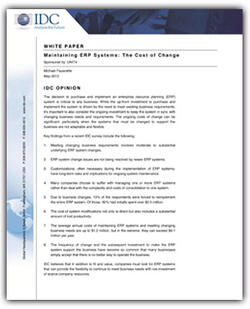 UNIT4 has released new survey results compiled in an IDC White Paper that clearly show that business-related change events are driving enterprise resource planning (ERP) system costs sky high despite the newer ERP systems recently introduced into the market. The survey, conducted by IDC, included 167 executives across North America and Europe. A copy of the IDC White Paper with survey results, "Maintaining ERP Systems: The Cost of Change" (May 2013) is available at: http://cloud.unit4.com/corp/docs/IDC%20-%20Cost%20of%20Change%202013.pdf
UNIT4 has released new survey results compiled in an IDC White Paper that clearly show that business-related change events are driving enterprise resource planning (ERP) system costs sky high despite the newer ERP systems recently introduced into the market. The survey, conducted by IDC, included 167 executives across North America and Europe. A copy of the IDC White Paper with survey results, "Maintaining ERP Systems: The Cost of Change" (May 2013) is available at: http://cloud.unit4.com/corp/docs/IDC%20-%20Cost%20of%20Change%202013.pdf
Most organisations that purchase and implement ERP systems, which are large in scope and connect to all of a business' operational areas, expect and budget for a hefty cost connected to the system's deployment. While on-going annual maintenance costs are predictable, the technology "budget buster" for many organisations is the unexpected high additional cost of managing ERP systems to meet business change requirements. According to the results of the survey, the price of change requirements averages $1.2 million per year and in the extreme can exceed $4.1 million a year after the initial deployment costs are borne. In fact, business-related circumstances forced 15 per cent of the survey respondents to have to re-implement their entire ERP system; of those organisations, 60 per cent report this was after an original $2.5 million cash outlay.
Many of the market's leading ERP vendors, including SAP and Oracle, have introduced major new releases and even new architectures in the recent past. "It would be a reasonable assumption that systems implemented in the last three years would be more modern ERP systems, and thus be more flexible and easy to modify," said Michael Fauscette, global vice president of Software Business Solutions, IDC. "The survey data though shows a very different picture."
Nearly 70 per cent of the respondents had implemented new ERP solutions in the past three years, and this group was the most likely to have needed to make moderate to substantial modifications to their systems due to business events, such as merger and acquisition activity, business process change, regulatory and financial change, and organisational change. While many of the newer ERP offerings cite the ability to support interoperability of various hardware and software systems, and use language like "agility" and "flexibility" in their marketing materials, the survey data shows that supporting business change is going to be costly, disruptive and time consuming for many organisations.
For example, to modify the underlying data structure underpinning the ERP solution just one time, the average estimate for the level of effort was almost 14 business days. Additionally, ERP system modification side-lines both IT and business people resources away from other strategic business activities, resulting in a substantial amount of lost organisational productivity.
There seems to be a sense of surrender by ERP users that the cycle of cost and disruption is inescapable. "The frequency of change and subsequent investment to make the ERP system support the business has become so common that many businesses simply accept that there is no better way to operate business," Fauscette said. "When evaluating the costs of an ERP system, it's not sufficient to look only at the upfront implementation and licensing investment. Organisations also need to factor the on-going system costs tied to inflexible systems that cannot accommodate business change – which include even the newest solutions introduced in the past three years. IDC found that companies need to do their due diligence and seek out ERP systems that can provide the flexibility to continue to meet business needs with low investment of scarce company resources."

Add a Comment
No messages on this article yet